Volleyball is a relatively simple game on the surface.
Whilst there are a variety of different ways to execute the different skills in volleyball there are primarily 4 different shots in volleyball.
The 4 shots in volleyball are as follows; the serve which is the first action that starts each rally, the pass which is sometimes known as a dig or bump, the set which is used to put the ball into a position for a teammate to attack and lastly we have the spike or hit.
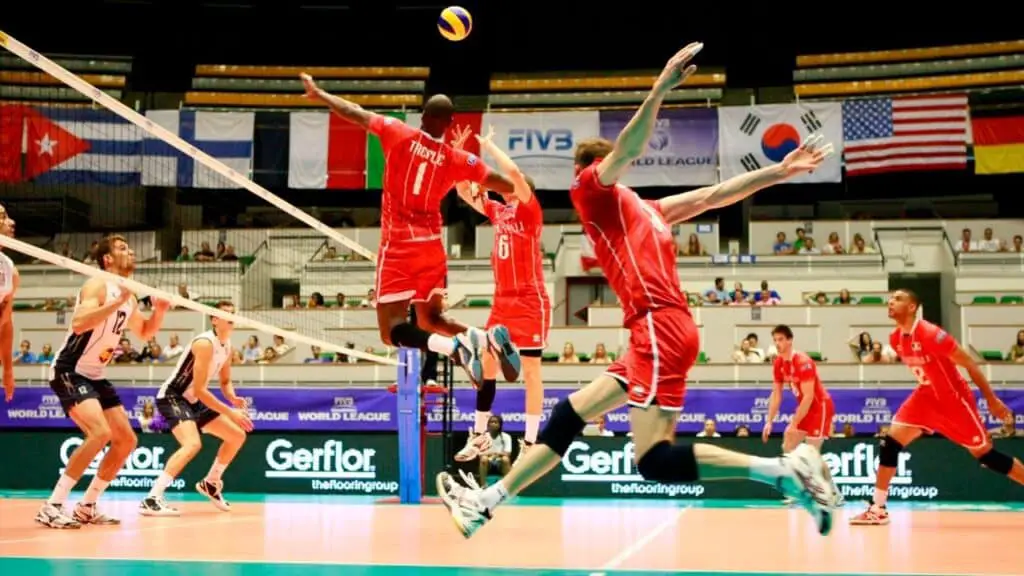
Whilst these are the 4 primary shots in volleyball there are actually a few different ways to execute each of these shots, this means when you start deep diving into the different volleyball actions there are actually several different shots.
Now I appreciate at the moment you may be scratching your head about how there are multiple different shots that fall under the umbrella term of serving, passing, setting and spiking.
But let me explain.
Table of Contents
Serving
Whilst serving is technically one shot regardless of how it is executed, as there are so many different ways to execute a serve you could argue that they are in fact all different shots.
Underarm
The first type of serve is the underarm.
This is the most common serve used by beginners who haven’t quite got the strength or mastered the technique of the overhand serve.
If you want to learn more about underarm serving you can read my article here.
Float
The float serve is a type of overhand serve in which the ball is contacted with a flat open palm.
The float serve is particularly tricky to execute and also receive.
The reason for this is because when a float serve is executed correctly the ball is contacted and no spin is added. With the lack of spin on the ball the flight path is determined by the air pressure within the hall, gym etc..
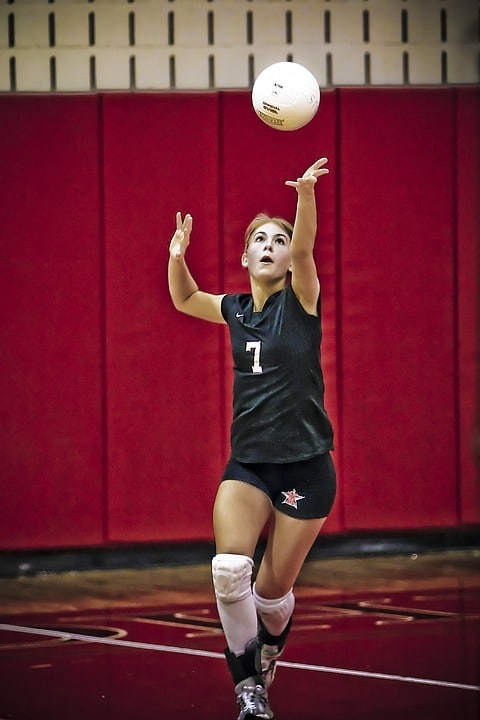
As the ball travels through the air and passes through different air pressures the ball can move irridactly and unpredictably making it very hard for the opposition to track and pass.
The float serve is extremely effective when mastered.
Jump Float
The Jump Float is the next progresive step from the traditional float serve.
The jump float whilst using the same technique as the traditional float serve adds another layer of difficulty to both execution and reception for the opposition.
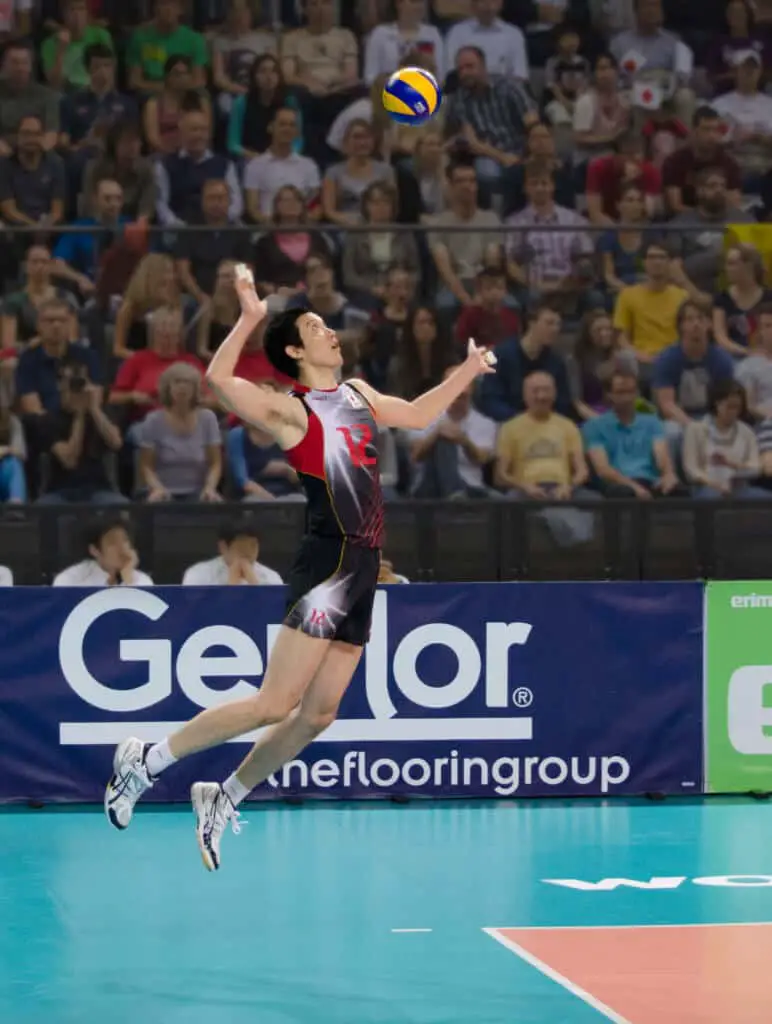
By jumping before executing the float serve it means the ball is contacted from a higher starting point which means the server can put more power on the ball and speed on the ball.
The reason for this is because the ball does not need to travel upwards first to ensure it gets over the net, instead it can be hit at a more flat trajectory.
Topspin Jump Serve
The topspin jump serve is often just referred to by many as the jump serve is the most challenging shot in serving.
It works very much on the basis of high risk, high reward.
The topspin jump serve is the one that we all aspire to be able to do with high consistency and power.
The topspin serve involves tossing the ball upwards before the service line by jumping up and serving the ball in a spiking motion.

The aim of the serve is create a lot of topspin and power so the ball reaches the oppositions side with a lot of power and speed whilst the topspin on the ball ensures the serve drops onto the oppositions side rather than keep travelling out the back of the court.
For more information on topspin jump serves or just serving in general, you can check out my article where I cover exactly how to execute each of these serve types.
Skyball
The last shot type under serving is not one that you will see very often.
In fact is somewhat more or a party trick and is often reserved for beach volleyball (For good reason)
The skyball is where the server aims to hit the ball as high as possible whilst still trying to ensure it lands on the opposition’s side.
Often this shot is executed using an underarm serve technique.
One of the main reasons why this shot lends itself so well to beach volleyball is due to the external elements which affect how the ball moves.
When the skyball is executed the ball travels very high and is often in the air for a long time, this offers lots of opportunities for the wind to move the ball around making it difficult to track.
The other benefits to using this serve in beach volleyball is the ball could become lost if in line with the sun.
The last reason why this serve is often saved for beach volleyball is because more often than not a beach volleyball court doesn’t contain a roof that would of course prevent how high a skyball could be hit.
If you want to catch your friends out next time you play beach volleyball, try a few skyballs.
If you want some inspiration I have included some clips of Adrian Carambula who is an italian beach volleyball player who has built up a bit of a reputation for skyballing in big games.
Passing
When it comes to passing I personally feel that passing is all the same regardless of when it occurs, there are many people however, who feel digging a ball is different to passing in a free ball.
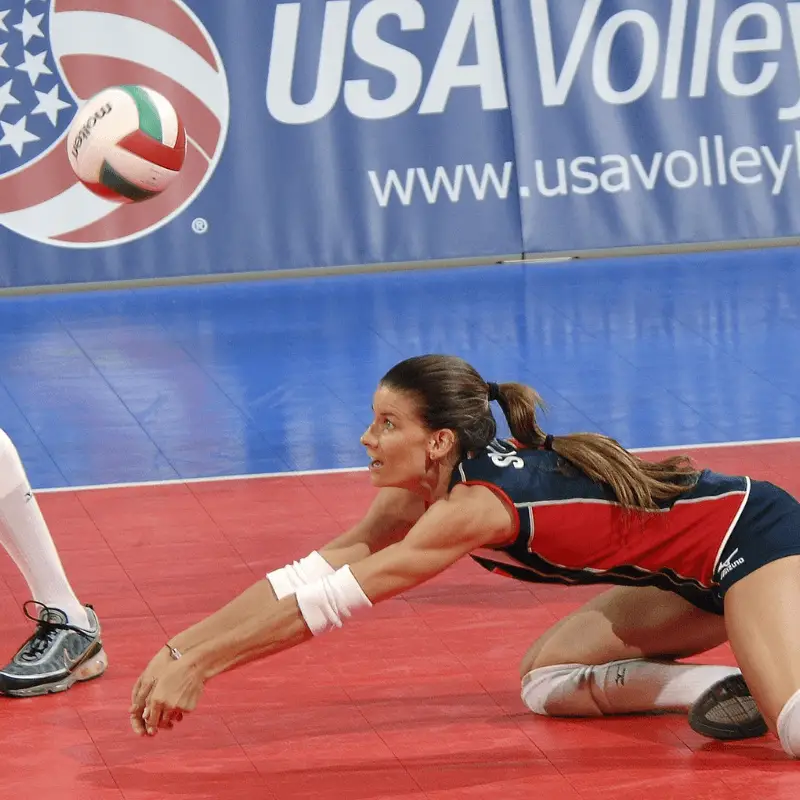
Digging
Digging a volleyball is when the ball is kept up and in play from an opponents attacking shot.
An example would be if you were able to dive and and save the ball after the opponents have just spiked the ball trying to win the point.
Digging is often seen as different to passing the ball up and to the setter after the opponents have given a free ball.
Giving a free ball in volleyball is when the opposition are struggling to keep the ball alive so they simply return it over the net so as to not instantly lose the point.
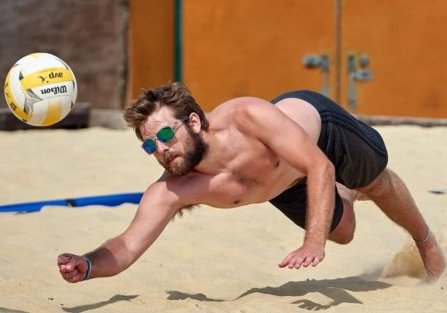
Oppositions will sometimes give a free ball to allow them time to reset and reposition.
The reason it is referred to as a free ball, is because it comes over the net with such ease that players shouldn’t struggle to pass it in, it is like being given a freebie.
Receiving
Receiving in volleyball is the term given to passing the ball in to the setter directly from an opposition’s serve.
Games are often won and lost and how well a team is able to receive the ball from an opposition’s serve.
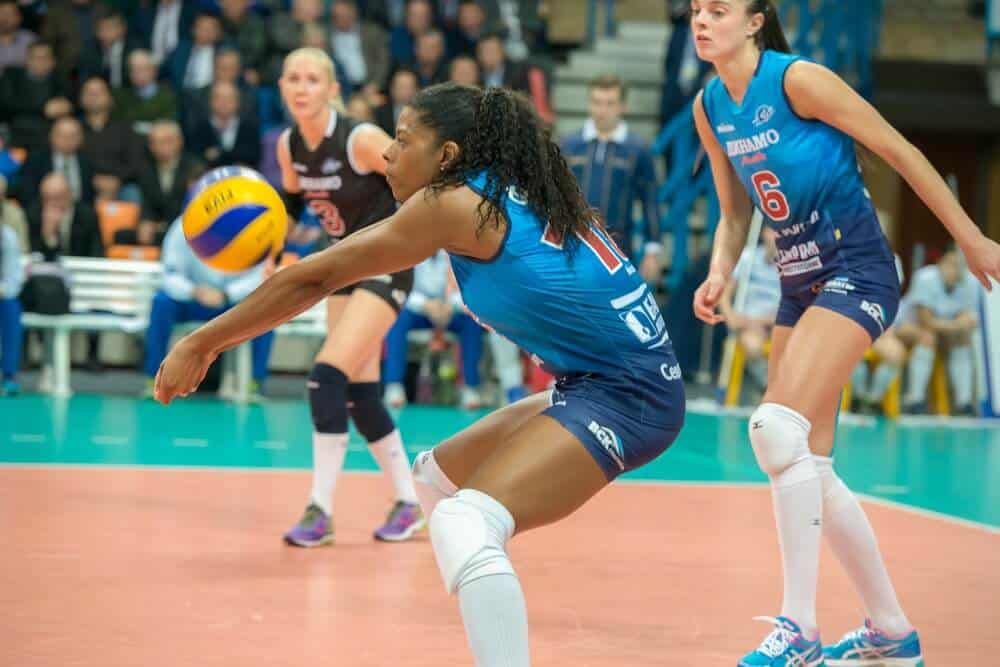
If you hear someone refer to a pass as receive or reception, they will be referring to passing the ball from the opponents serve.
Set
Setting is the act of putting the ball up and infront of one of your attacking players so that they can spike or hit the ball to try and win the point.
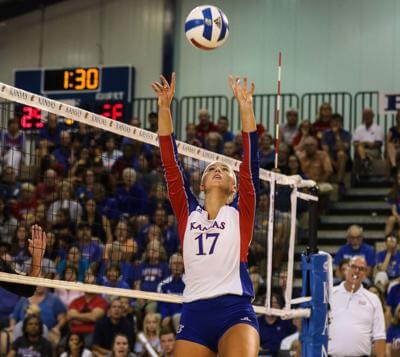
When it comes to setting there are two main ways in which a ball can be set.
Volley
The first method is the most traditional method and is the one that ideally we want to use whenever possible.
This is known as the volley.
The volley is where the ball is taken overhead using the hands and then released into the correct position for a spike.
If you need something to reference what a volley looks like, remember your spot and quickly head up to the top of the page to see my logo.
For detailed guides on how to volley a ball you can read my article here, or alternatively check out my video on youtube below.
Bump Set
The other setting shot is known as a bump set.
The bump set is used when the setter physically can’t volley the ball either due to the pass in being shanked or the defence dig being too far away for the setter to get underneath in time.
The bump set involves using a passing platform to push the ball into position.
It is called a bump set as you use your platform to simply bump the ball into the correct area.
Spike/ Hit
Spike
The spike has many names and depending on where you are playing, who you are playing with and how you executed the shot, will depend on what people call it.
The spike is also known as the hit, the smash and the attack.
The spike is the last motion in your team’s touches, after the setter has put the ball up in the air, a player will come through and spike the ball trying to make it land on the opponent’s side and within the lines.
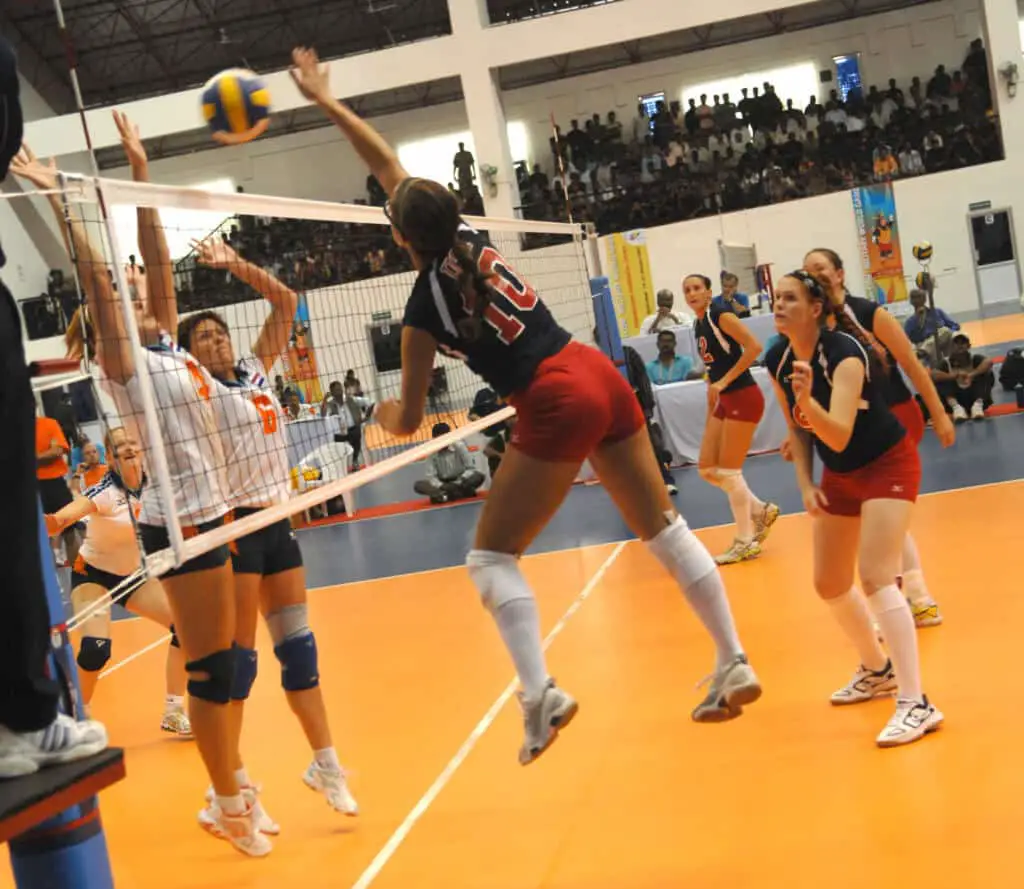
The spike is normally a hard driven shot in which you are trying to force the ball to land on the floor, this is often achieved by hitting with great speed and power or by hitting the ball into hard to reach areas.
If you want some spiking inspiration, check out the below video of some of the best spikes in volleyball.
Tip
The tip is a shot that is used in indoor volleyball to try and catch out the opposition.
The tip involves gently placing the ball onto the opponent’s side by either playing the ball just over the top of the blockers reach so it lands directly behind them or by pushing the ball just past the blockers reach so it lands tight to the net.
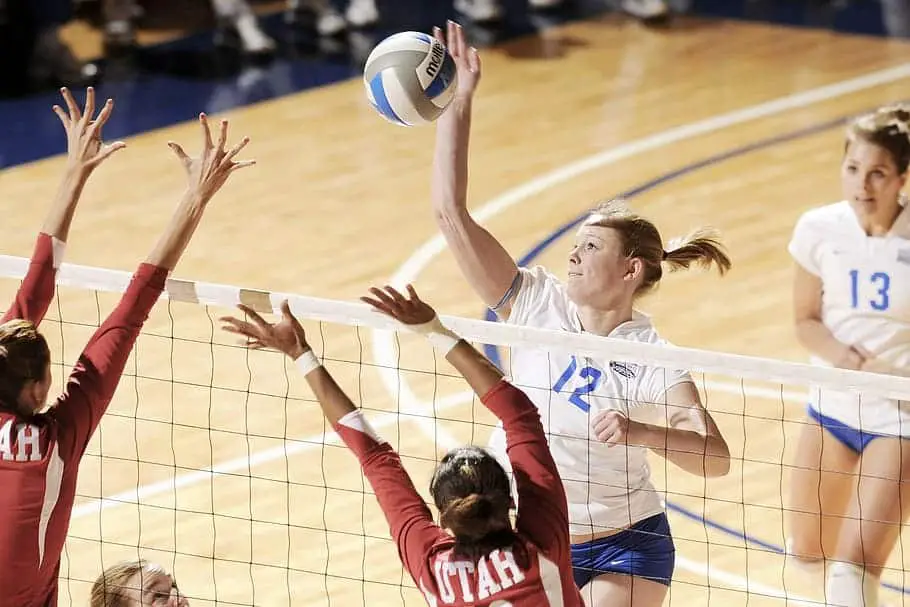
To perform a tip you would want to jump and shape up as if you were going to smash the ball, as you begin to swing your arm forward, you slow down your shoulder speed and gently push the ball over the net.
Think of it like having a book standing half on the table and half off the table, to get that book to topple off the edge you would only need to apply a very gentle touch to make it ‘tip’ over.
Pokey
The pokey is a shot that is often used in beach volleyball, the pokey is the beach version of the tip.
In beach volleyball you are not allowed to perform a tip in the way that you can in indoor volleyball, it would be considered a carry.
This is where the pokey comes into play.
The pokey can be executed in multiple different ways but normally it involves poking the ball knuckles on your fingers (or PIP joints on the fingers).
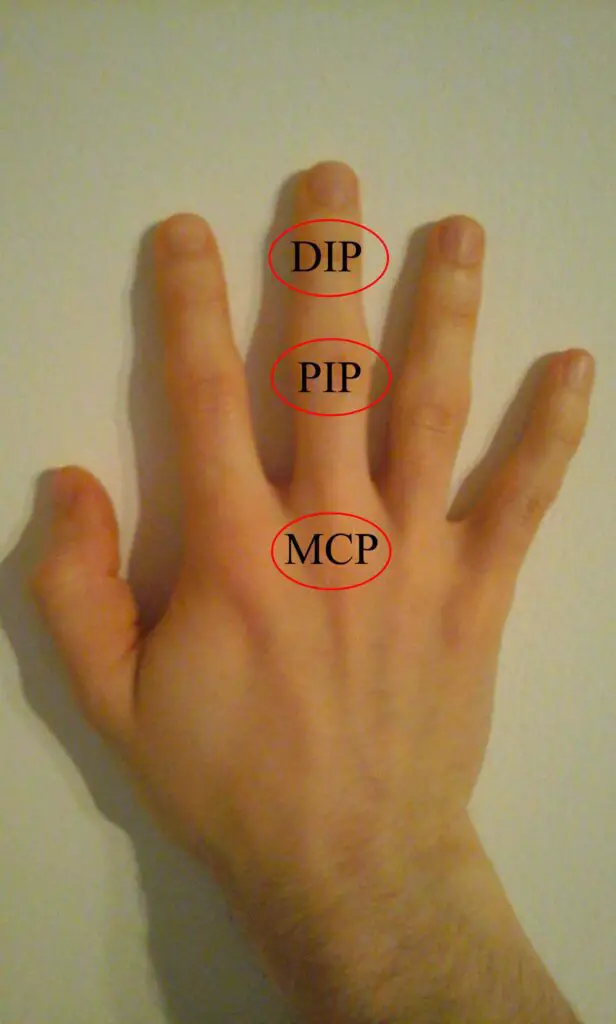
By using this technique you ensure the ball is contacted cleany and in one motion which removes any claims of it being a carry.
The pokey can be used in a number of different ways from reaching to pokey the ball and push it over a closely contested block or pokey sharp and tightly along the net to catch the opposition off guard.
Whatever the reason the pokey can be a fantastic shot to master especially for beach volleyball
Cut Shot
The cut shot again is a shot that is often reserved for beach volleyball but does certainly have it’s place in the indoor game.
The cut shot is normally used when a player is hitting from near the antennas on the net, the cut shot involves playing the ball sharply and tightly along the net so it lands just over the net on the opposition’s side.
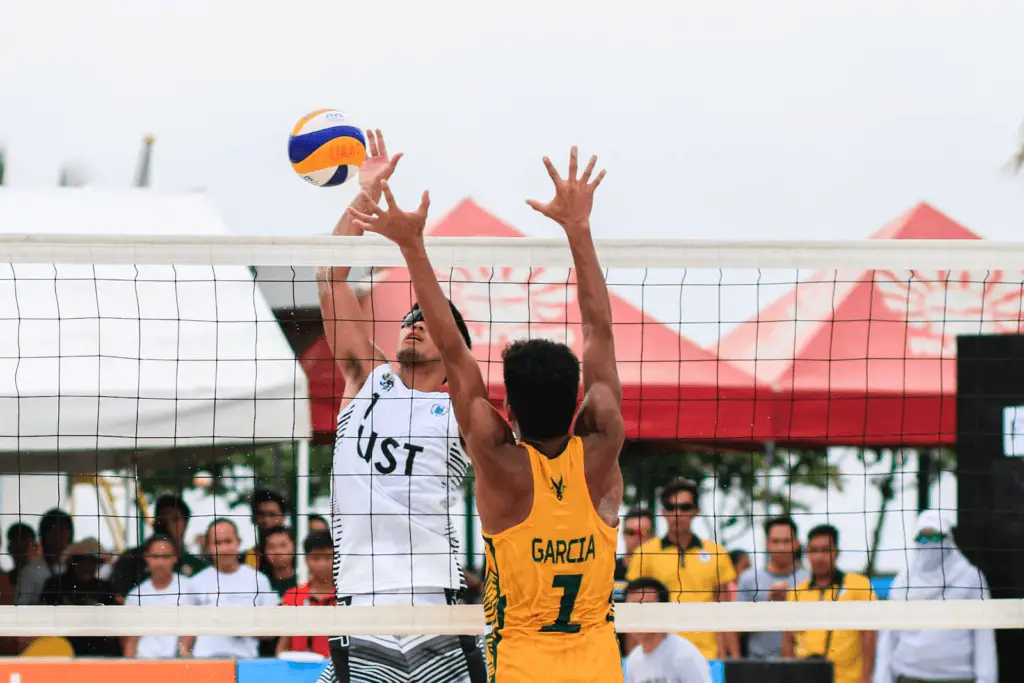
It is called a cut shot because often you will cut across the ball to create extra spin so that the ball spins downwards and back towards the net making it much harder to pick up.
Although the cut shot is often used in beach volleyball it can actually be a great shot to have in your arsenal, specifically if the outside player on the opposition team is being lazy and not playing defense.
Line-Over
The line-over is yep you guessed it, another beach volleyball shot.
But like the cut shot it does have its place in indoor.
The line-over is a shot where you hit the ball high and over the top of the blockers/ defenders along the line you are hitting from.
An example would be, if I was hitting from the left side of the court, I will hit the ball straight down the line but nice and high so that it goes over the blocker and or defenders.
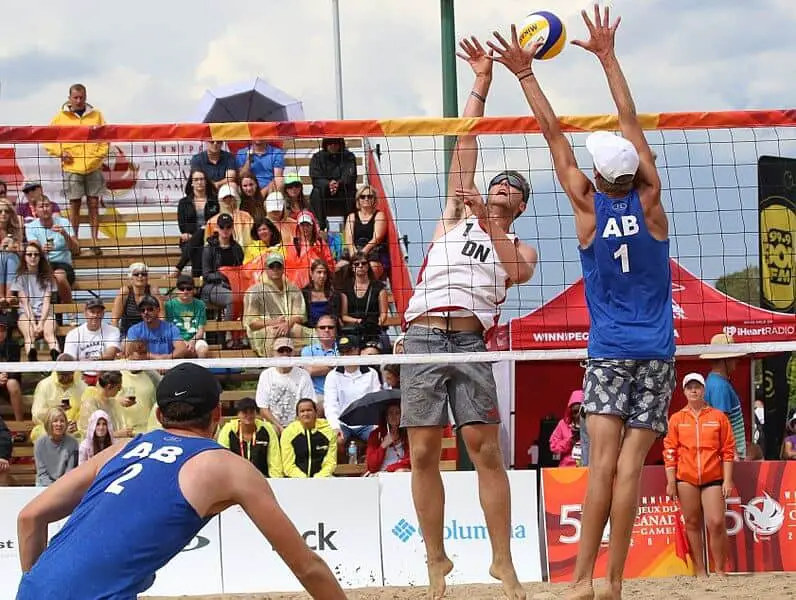
This is a shot that works well in beach volleyball as obviously there are only two players on a beach volleyball team, if the blocker is blocking your line hit, the defender will be standing cross court.
If you can lift the ball over the top of the blocker and down the line, you will be able to beat the blocker and make it very hard for the cross court defender to reach the ball in time.
Although it is harder to get away with in indoor volleyball it can still be quite a good shot to get you out of trouble.
When hitting in indoor volleyball you may notice that the defender behind the blockers is creeping forward towards the net, if you do happen to spot this, try and play a deep shot down the line and you may find you can hit over the blockers and the defenders using the line-over.
Jumbo
The last shot has many names and I think depending on what country you come from it is called different things.
I have always known it to be a jumbo but I have heard it called the following:
- Jumbo Shrimp
- Shrimp
- Rainbow
- Looper
The jumbo is similar to a line-over shot in that it involves playing a ball high over the top of blockers/ defenders but it is often hit cross court rather than down a line.
To execute a jumbo shot you will want to play the ball high enough so that it is out of the opponents reach and you will also want to play it long enough so that it lands just inside the back line.
The flight path should resemble the shape of a rainbow or jumbo shrimp, hence the names.
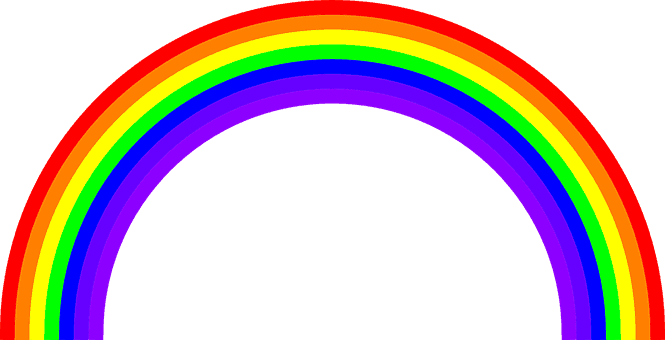
It can be a really effective shot to catch out the opposition and even if it does not result in a point, it is still very challenging for the opposition to pass back to the setter.
If you want to make your opponents look rather silly why not hit them with a jumbo shot.
